#Cypress Point Public Use Area
Explore tagged Tumblr posts
Text


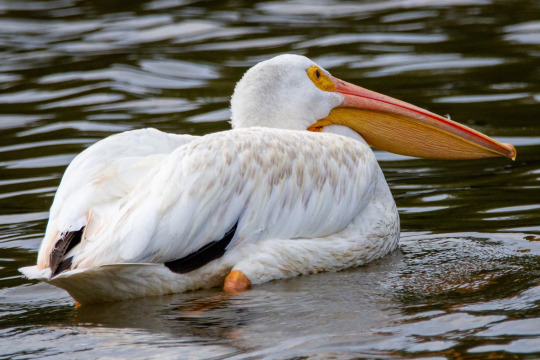

American White Pelican, Cypress Point Public Use Area, Ellzey Rd, Sardis, Mississippi, USA
Joshua J. Cotten
Scientific name: Pelecanus erythrorhynchos
Mass: 14 lbs (Adult)
Conservation status: Least Concern (Population increasing)
Class: Aves
Domain: Eukaryota
Family: Pelecanidae
Genus: Pelecanus
The American white pelican is a large aquatic soaring bird from the order Pelecaniformes. It breeds in interior North America, moving south and to the coasts, as far as Costa Rica, in winter.
#American White Pelican#Cypress Point Public Use Area#Ellzey Rd#Sardis#Mississippi#USA#MSWildlife#Wildlife#Birds#Bird#Pelican#Pelicans#US#United States#United States of America#North America#Pelecanus erythrorhynchos#Aves#Eukaryota#Pelecanidae#Pelecanus
4 notes
·
View notes
Text
"In China, a landscape architect is reimagining cities across the vast country by working with nature to combat flooding through the ‘sponge city’ concept.
Through his architecture firm Turenscape, Yu has created hundreds of projects in dozens of cities using native plants, dirt, and clever planning to absorb excess rainwater and channel it away from densely populated areas.
Flooding, especially in the two Chinese heartlands of the commercial south and the agricultural north, is becoming increasingly common, but Yu says that concrete and pipe solutions can only go so far. They’re inflexible, expensive, and require constant maintenance. According to a 2021 World Bank report, 641 of China’s 654 largest cities face regular flooding.
“There’s a misconception that if we can build a flood wall higher and higher, or if we build the dams higher and stronger, we can protect a city from flooding,” Yu told CNN in a video call. “(We think) we can control the water… that is a mistake.”

Pictured: The Benjakitti Forest Park in Bangkok
Yu has been called the “Chinese Olmstead” referring to Frederick Law Olmstead, the designer of NYC’s Central Park. He grew up in a little farming village of 500 people in Zhejiang Province, where 36 weirs channel the waters of a creek across terraced rice paddies.
Once a year, carp would migrate upstream and Yu always looked forward to seeing them leap over the weirs.
This synthesis of man and nature is something that Turenscape projects encapsulate. These include The Nanchang Fish Tail Park, in China’s Jiangxi province, Red Ribbon Park in Qinghuandao, Hebei province, the Sanya Mangrove Park in China’s island province of Hainan, and almost a thousand others. In all cases, Yu utilizes native plants that don’t need any care to develop extremely spongey ground that absorbs excess rainfall.

Pictured: The Dong’an Wetland Park, another Turescape project in Sanya.
He often builds sponge projects on top of polluted or abandoned areas, giving his work an aspect of reclamation. The Nanchang Fish Tail Park for example was built across a 124-acre polluted former fish farm and coal ash dump site. Small islands with dawn redwoods and two types of cypress attract local wildlife to the metropolis of 6 million people.
Sanya Mangrove Park was built over an old concrete sea wall, a barren fish farm, and a nearby brownfield site to create a ‘living’ sea wall.
One hectare (2.47 acres) of Turenscape sponge land can naturally clean 800 tons of polluted water to the point that it is safe enough to swim in, and as a result, many of the sponge projects have become extremely popular with locals.
One of the reasons Yu likes these ideas over grand infrastructure projects is that they are flexible and can be deployed as needed to specific areas, creating a web of rain sponges. If a large drainage, dam, seawall, or canal is built in the wrong place, it represents a huge waste of time and money.

Pictured: A walkway leads visitors through the Nanchang Fish Tail Park.
The sponge city projects in Wuhan created by Turenscape and others cost in total around half a billion dollars less than proposed concrete ideas. Now there are over 300 sponge projects in Wuhan, including urban gardens, parks, and green spaces, all of which divert water into artificial lakes and ponds or capture it in soil which is then released more slowly into the sewer system.
Last year, The Cultural Landscape Foundation awarded Yu the $100,000 Oberlander Prize for elevating the role of design in the process of creating nature-based solutions for the public’s enjoyment and benefit."
-via Good News Network, August 15, 2024
#china#wuhan#thailand#bangkok#landscape#wetlands#sponge city#landscape architecture#flooding#climate action#parks#public park#green architecture#sustainability#good news#hope
988 notes
·
View notes
Note
hi mila my cy loving ass is once again sliding in your inbox sjdjakdk can i please ask for "All these people think love's for show but I would die for you in secret" + cypress? thank you hehe 🩷
"The whole point of me being retired is so I don't have to go to these events."
Cypress has adjusted their necklace multiple times, the same with the thin rings on their fingers. You're sure they're about to lean down and check whether there's a speck of dust on their shoes before you place a gentle hand on their shoulder.
"That is not why you retired," you utter with a laugh.
"Fine, but this isn't something I miss about being a player."
"Aren't you the one who booked this limousine for us to come here?"
Cypress snorts. "Well, sure," they murmur, "but I booked it for you," they say with ease as the limousine comes to a stop. "And now you have me in formal attire."
You smile. "Formal attire that you look great in."
The corner of Cypress's lips threaten to turn upwards as their eyes quickly scan you over you. "That kind of flattery doesn't work on me."
You huff. "We're a couple, it has to work on you at some point."
A light chuckle escapes them as they open the limo door and offer you their hand. Cypress steps out and they're immediately met by the flash of cameras. You take hold of their hand and step out too, and suddenly the camera flashes double.
The two of you are the ones they want to see at this award show, that's evident.
Cypress loops an arm around your waist, they turn their body towards you, as though they're acting like your shield. "Your flattery has worked on me. You're the only person who could get me to come to one of these things."
—
It's like a red carpet event. Cypress has been by your side the whole time. Their arm around your waist, their hand holding yours, your pinkies linked together—some kind of physical connection to each other.
The event hasn't been terrible. Cypress is usually itching to leave as soon as they step on the carpet, their thoughts drifting to being in much calmer environment.
But with you it isn't all that bad for them. Even when microphones are being pushed in your faces.
"Away from your football on the pitch, the two of you are one of the world's most famous couples," an interviewer says, light shining in their eyes as they dig for a good story. "Together you're an unstoppable force."
The interviewer turns to Cypress specifically, hoping to force an answer out of them. "Inter City's season gone superbly considering they won a trophy. You must be proud of your partner."
Cypress laces their fingers with your own, glancing over at you for a brief moment. "I'm proud of them no matter what," they say without hesitation.
The interviewer arches a brow. "I can quote you on that?"
"Obviously," Cypress says. "The media can paint it how they like but they mean everything to me," they add, referring to you before they give your hand a squeeze three times—a signal you give one another when you're in public when one of you feel ready to leave.
You manage to come up with an excuse, a polite one that allows you to leave and continue along until the two of you get to a quiet stretch of the carpet.
There aren't too many people around this area, and the ones that are around are ones you know. You take Cypress's hand and pull them to stand in front of you.
"You okay?" they question.
You nod your head before smirking. "I mean everything to you, huh?" Your hand cups their cheek and your thumb brushes over the heart-shaped birthmark by their jaw.
Cypress rolls their eyes. A lopsided grin is visible on their lips before they go to peck the pad of your thumb.
"Shut up," Cypress mumbles. "You know I'd do anything for you. I'd give you the world if I could."
#drabble#cypress de vera#I feel like this will be in game at some point#I love getting my characters dressed up for formal events <3
22 notes
·
View notes
Text
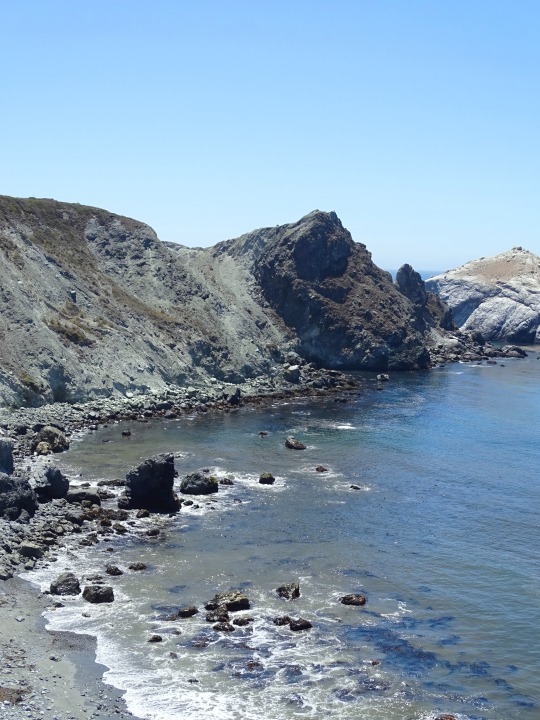
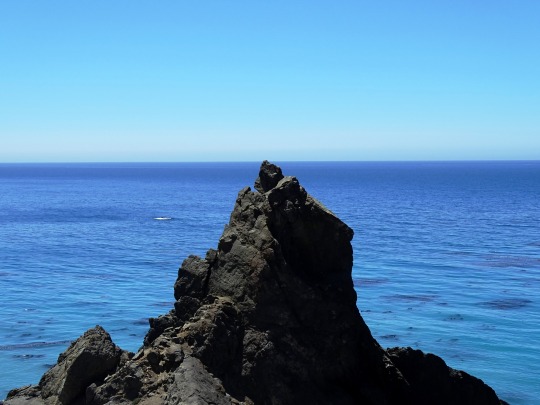

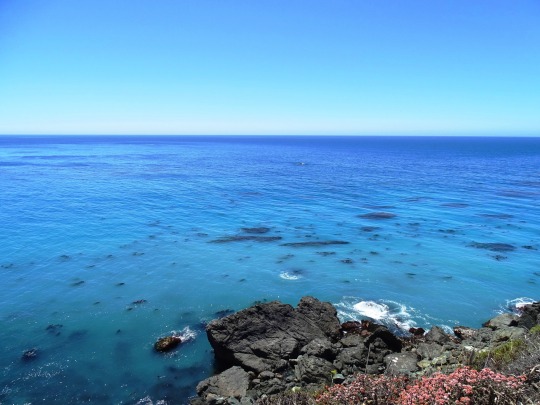

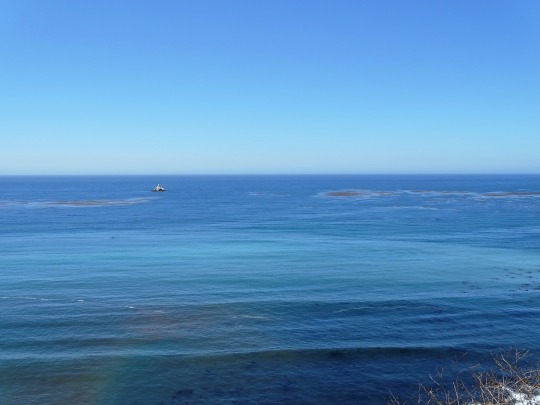
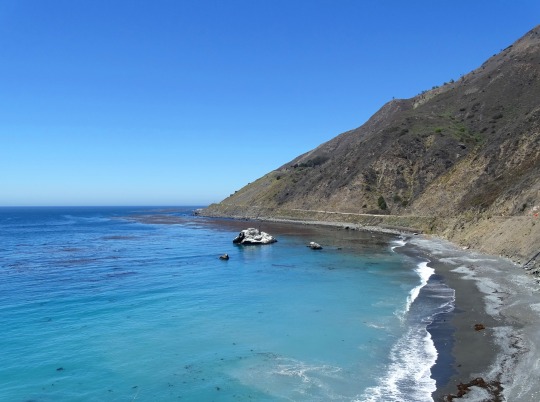
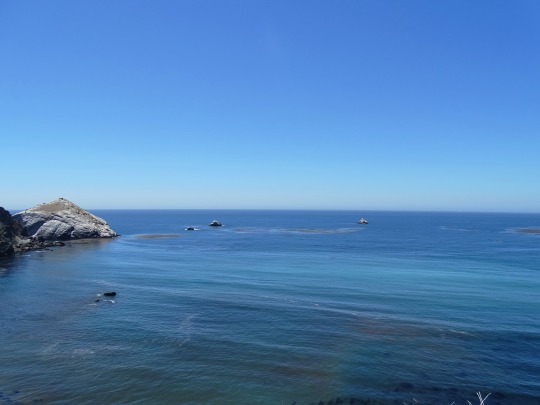

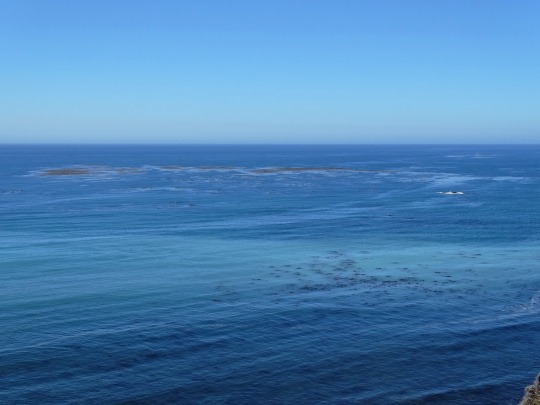
Black Sand Shores, CA (No. 5)
In 1909, an advertisement for the Idlewild Hotel on the Little Sur River stated that the camp would be accessible by auto as soon as the "Cerro Grade", the stretch of road from the coast to the Little Sur River near Cerro Hill, was completed. In 1910, the Monterey Daily Cypress reported that Mr. and Mrs. A.E. Cooper "motored down to Mrs. Martha M. Cooper ranch at Sur, leaving Monterey at 12 midnight and arriving there at 2 a.m." But the road was still very rough, and most goods including cheese produced on the Cooper Ranch was still shipped by boat to Monterey. The Idlewild competed with the Pfeiffer Resort for guests through about 1920, when the Idlewild was forced out of business by Martha Cooper, who acquired the land. In 1904, residents extended the unpaved road from the Pfeiffer Resort to the Post Ranch, and then it was extended another 2.5 miles (4.0 km) south to Castro Canyon, near the present-day location of Deetjen's Big Sur Inn.
As late as the 1920s, only two homes in the entire region had electricity, locally generated by water wheels and windmills. Most of the population lived without power until connections to the California electric grid were established in the early 1950s. The region has always been relatively difficult to access and only the sturdiest and most self-sufficient settlers stayed.
In July 1937, the California Highways and Public Works department described the journey, "There was a narrow, winding, steep road from Carmel south ... approximately 35 miles to the Big Sur River. From that point south to San Simeon, it could only be traveled by horseback or on foot."The southern portion, which was for many years merely a foot and horse trail, became known as the "Coast Ridge Road". It used to begin near the Old Post Ranch. It is currently only accessible on foot from near the Ventana Inn. It passes through private land and connects with the Nacimiento-Fergusson Road. It follows the crest of the coastal ridge south about 34 miles (55 km) to within a couple of miles of Cone Peak. Both the Old Coast Road and the Coast Ridge Road are often unusable during and after winter storms.
The southern region of Monterey County coast was isolated from the few settlements in the north by the steep terrain. The southern homesteaders were more closely tied to the people in the interior San Antonio Valley including the Jolon and Lockwood areas than to coastal communities to the north. Those who lived in the vicinity of the Big Sur River were connected with Monterey to the north.
A horse trail connected Jolon through present-day Fort Hunter Liggett to Wagon Caves, and from there over the Santa Lucia range, from which two trails split to the coast or to the Los Burros Mining District.
The horse trail across the mountains was widened and improved into a road beginning in 1931, and completed in 1937. The road was constructed by crews composed of men from the Civilian Conservation Corp, U.S. Forest Service, and state and county relief agencies.
Source: Wikipedia
#Black Sand Shores#California State Route 1#Highway 1#Pacific Coast Highway#National Scenic Byway#Big Sur#Pacific Ocean#travel#original photography#vacation#tourist attraction#landmark#landscape#seascape#countryside#street scene#road trip#summer 2022#California#West Coast#Big Sur Coast Highway#nature#flora#grass#tree#USA#blue sky#blue sea#beach#waves
2 notes
·
View notes
Text
Towers, Trails & Wooded Treks at Withlacoochee River Park

Palmetto bushes, towering over six feet and flanking both sides of the worn dirt path, their spiky fronds big enough to use as sunshade umbrellas. A red-headed woodpecker soared through the canopy overhead, settling in the crook of a rotted tree trunk, already punctured with holes, ready to tap for bugs. Tall pines reached through the canopy for the sky, shadowing the oaks below- and beyond, a stand of cypress trees stretched out as far as the eye could see. Giant palmetto stands frame the FT trail through the woods at Withlacoochee River Park. Photo by Sally White A panther would not have gone amiss in the landscape, silently sliding through the green fronds to stalk prey and lounging overhead on the hefty live oak limbs among a bed of moss and resurrection ferns. Florida panthers primarily live in the southwest region of the state, but sidled up to the 560,000 acres of Green Swamp, the idea is not far-fetched. Over 300 species of mammals, reptiles, birds, and fish live in the Green Swamp; the headwaters of the Withlacoochee River. In the distance, the Withlacoochee River snaked a path through the pale cypress trees, beckoning like a Southern siren: “I’ve got bass. Come find me.” Muddy floodplains and swamp separated me from the river, but would these orange blazes that guided the way on the trail curve back beside the winding Withlacoochee again, or would they lead away from the wetlands to amble towards the drier sand plains and slash pines? That’s about when I heard the rumble- a low rolling growl. I stopped in my tracks. I’d been thinking too much about panthers in the palmettoes. Another low growl sounded, followed by a gurgle that made me burst out in a relieved laugh. 2 ½ miles in and my own stomach had turned on me, reminding me hours had passed since breakfast and those teriyaki beef jerky sticks that I’d picked up at the gas station were waiting in the car, where I’d left them so as not to entice the local wildlife that I had undoubtedly just scared away. I was hiking on the Florida Trail in Pasco County… or so I thought… Climbing the 4-story observation tower at the Withlacoochee River Park. Photo by Sally White The Withlacoochee River Park Tower above Green Swamp West Earlier in the day, I arrived at the Withlacoochee River Park in Dade City to find a 40-foot wooden observation tower that overlooked the 406-acre county park along the river. Not much is written about this public green space. A blurb on the Pasco County website and a mention here and there. For years, this was the place for the annual Mittie Wood Memorial Mother’s Day Native American Pow Wow an event founded by Muscogee Creek native Mittie Wood and her family to educate the public about the native American culture, and dedicated to her mother, Big Ma and all mothers. The Memorial Mother’s Day Pow Wow was held annually for over 20 years at the park. Although the Mother's Day Pow Wows here have ceased, Mittie Woods's memory lives on at Withlacoochee River Park. Photo by Sally White Today the park hosts gatherings for family get-togethers and kids’ parties and the occasional county event, like the upcoming Bay Area Renaissance Festival (weekends from February 17 through March 31). Marked walking trails and a paved multi-purpose trail through the park entice hikers and cyclists for a fresh-air adventure. I followed the winding road through the park past picnic pavilions, playgrounds, and restrooms to the last parking area, the access point to the observation tower and boardwalk. A short hike on a sandy track led up a hill to a wooden platform tower. Somewhere out there is the Green Swamp and the river- It's a treetop view from the observation tower at Withlacoochee River Park. Photo by Sally White At the top and all around the wooden fourth-floor deck, towering trees vied for their spot in the sun on the canopy roof, and the forest stretched out on all sides. Somewhere out there was the western edge of the Green Swamp and the winding Withlacoochee River. I just couldn’t see it from here. Withlacoochee River Park Boardwalk Back down on ground level, I followed the sign pointing the way to the boardwalk on the opposite side of the hill. At the bottom of the slope, the trail split, each path marked with a different color post. One wrong path and then onto red marked trail led to a wooden boardwalk that once carried hikers across a swampy area, but the drought dried up the wetlands, leaving a grassy pasture. The trail curved upward, back into the shade of the forest canopy. It was dry season at the wetlands boardwalk in Withlacoochee River Park. Photo by Sally White Blue, red, and yellow marked trails crisscrossed an all-purpose newly tarmacked path through the woods. Families strolled the paths, joggers, and cyclists sped by. A beautiful Saturday had everyone outside. I followed the paved trail back, past the lichen-covered ground, the fallen trees, and the resilient live oaks, their limbs stretched out, touching the ground. A pleasant walk. Nice playgrounds & clean toilets. This was a green space for locals to enjoy. Which way to go The trails are color-coded at the Withlacoochee River Park. Follow the red blazes to reach the boardwalk from the observation tower. Photo by Sally White Fishing Pier and a Special Find Before leaving the park, I stopped at the fishing pier- one quick picture to take before heading home, but I never reached the wooden dock, because, to the right of the ramp, I saw the sign: FT. Florida Trail. On the Florida Trail... or So I Thought That legendary 1500-mile Florida National Scenic Trail is a series of connected hiking trails and byways leading from the panhandle and winding down through wild places in the State all the way to the Florida Everglades. It’s the path to lose yourself on. The path to find yourself on. The Appalachian Trail of the South. The challenge just waiting to be conquered. And many try. But few make the entire length, and when they do, they too become legends. Yes, indeed, heady stuff of dreams. Of course, it went straight to my head. Finally on the FT at Withlacoochee River Park - or was I? Photo by Sally White I grabbed some more water for my day pack and set off on the trail, following the famous orange blazes painted on the trees to guide the way. About Those Orange Blazes When you are standing at one orange trail blaze, you will be able to see the next one from there, making your hiking travels easy. The trail ran parallel to the winding Withlacoochee River with access points. Perhaps they were only deer paths leading to the water? Knobby cypress knees jutted up along the river, their entwined roots providing support for the embankments, while Ibis pecked their peculiar long thin beaks through the river bank mud to search for tasty bugs. Symphony of nature. A pine and oak co-mingle on the FT at Withlacoochee River Park. Photo by Sally White The river ran through the trees, around island mounds, and cascaded over limestone and cypress roots. A symphony of nature. Overhead the clouds dissipated leaving a brilliant blue sky. Tiny white spring flowers decorated the fresh new greenery around the river banks, ready to welcome in an early spring. The trail turned away from the river and wound beneath a stand of old oaks, each leaning away from the river, their hefty branches bending low. Vines sprinkled with wild yellow Carolina jessamine flowers surrounded tree trunks with halos of color. The entire time I hiked I kept thinking- if I just keep walking, I could end up in the Everglades! The Withlacoochee River starts in Green Swamp and winds 160 miles across the state to the Gulf of Mexico by Yankeetown. Photo by Sally White A group of young men bearing homemade walking sticks, aka sturdy branches, passed by as they came out of the woods, as did a family with kids and hiking couples. A busy trail day. A sandy service road cut across the blazed trail. A less scenic shortcut from the well-maintained FT. “It’s a quicker way to the river," one hiker heading back assured me. I turned onto the service road. The sandy path cut through cypress trees and cypress knees. Swamplands stretched out to the left- an endless labyrinthine maze of tall cypresses leading to the river. In the wet season, this area would be underwater, but right now, high and dry. An unusual trail marker points the way on the Florida Trail in Withlacoochee River Park. Photo by Sally White An animal skull perched on a trail marker, and the crossing of the FT across the service road. The trail headed back into the woods- the way to the river. Back on the FT, I crossed a small grassy meadow, newly cut by a trail keeper, and dove into the depths of the palmetto forest. Darker and wilder. The river had to be near. I could see it across the swamplands, an opening of blue, but the path turned away again and my stomach growled. A lizard shot across the ground, rattling the leaves. Rattling me. I still had panthers on my mind. It was time to return to civilization. I would not be getting my thru-hiker star but it was a start, wasn’t it? A Florida Trail, but Not THE Florida Trail The Florida Trail-marked river trail at Withlacoochee River Park was created in the 1970s. The four-mile trail was an original proposed section of the Florida Trail Route, but the official trail ended up being routed to the east side of the Withlacoochee River. Here's your sign! Florida Trail sign by the fishing pier...or was it? This trail was created as part of the original Florida Trail but never made the final cut. It now enjoys honorary Florida Trail status. Photo by Sally White This path never became a part of the Florida National Scenic Trail. Its trailkeepers, the Florida Trail Association Suncoast Chapter, continue to keep those honorary orange blazes bright and maintain this trail for visitors to enjoy. Withlacoochee River Park is located at 12449 Withlacoochee Blvd, Dade City, Florida. This is a free Pasco County park for day use, open from dusk to dawn, 7 days a week. The entrance to Pasco County Park's Withlacoochee River Park. Image by Sally White. Read the full article
0 notes
Text
The Peaches along the Georgia Golf Trail
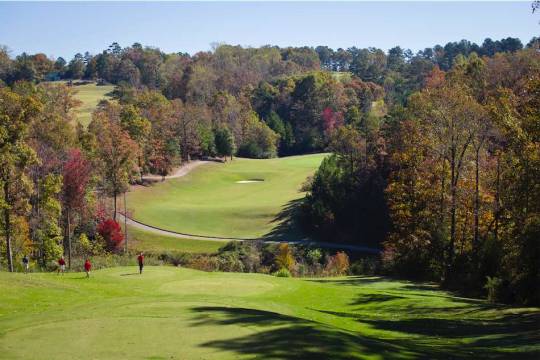
Of the 20+ golf courses on the Georgia Golf Trail, nine of them are tucked away in nine of Georgia’s state parks. While some of these golf courses may be off the beaten path, so to speak, they are worth making the effort to go play. “Our state park golf courses in Georgia are terrific golf destinations. They are incredible designs which are very well maintained and fairly priced,” said Doug Hollandsworth, Founder, Georgia Golf Trail. “The affiliation of these golf courses with amenity filled state parks makes them a perfect place to visit, especially with your families.” HIGHLAND WALK - There are many scenic selfie ‘hot spots’ at Highland Walk Golf Course (706-245-6770) at Victoria Bryant State Park in Royston. At Highland Walk, there are many uphill and downhill tee shots. The best photo ‘opp’ locale is the tee box of the signature hole -- the 17th. Arrowhead Pointe Golf Club overlooking Lake Russell ARROWHEAD POINTE - At the Arrowhead Pointe Golf Course (706-283-6000) in Elberton, visiting golfers will discover a 6,800-yard course situated on a peninsula within the Richard B. Russell State Park. Arrowhead Pointe deserves to be called the ‘Crown Jewel’ of the Georgia Golf Trail. Here, 10 of the 18 holes border Lake Richard B. Russell. THE CREEK - The Creek Golf Course (706-557-3006) at Hard Labor Creek State Park in Social Circle is a joy to play. Here, the sternest test is the tee shot on the par-four 10th hole, formerly the opening hole, which used to be considered “the hardest first starting hole in Georgia.” BRAZELL’S CREEK - The Brazell’s Creek Golf Course (912-577-7745) at Jack Hill State Park in Reidsville is a well-designed par-71 layout. At Brazell’s Creek, a 1,500-yard winding bridge through a canopy of trees connects the front nine with the back nine. The back nine was built on a windswept, open landscape with a links-style look. The front nine is tree-lined, and the greens have some creative contours. THE LAKES - The Lakes Golf Course (912-285-6154) at Laura S. Walker Park in Waycross is the southernmost golf course on the Georgia Golf Trail. It features large, undulating greens. The fairways and landing areas are defined with gentle, links-style mounds that accent the course’s three large lakes. Loblolly pines are a common sight at the Lakes GC, which is an easy course to walk. MEADOW LINKS - The Meadow Links Golf Course (229-768-3714) opened in the George T. Bagby State Park in Fort Gaines in 1998. Golf Digest ranked Meadow Links as “the nation’s sixth-best new affordable public course.” Each day, when the sun sets in the west, the views resemble a picture postcard. Explore The Wonders Of Nature and experience the comfort Of Brastown Valley Resort and Spa. BRASSTOWN VALLEY RESORT & SPA - Golf at Brasstown Valley Resort & Spa (706-379-9900) is refreshing, delightful, and scenic. The views of the surrounding mountains from the golf course are stunning. This golf course is in terrific shape. Afterward, get a massage at the Equani Spa, swim in the indoor pool, eat at Brassie’s Grill, spend the night at the resort, and wake up next door and do it all again! It's a total escape! WALLACE ADAMS - Once you arrive at the Wallace Adams Golf Course (229-868-7474), located in the Little Ocmulgee State Park outside McRae, you’ll quickly see that you’ll want to play this course more than you had originally intended. This golf course has an Augusta National Golf Club look and feel to it. And it’s true. The only things missing are patrons, leaderboards, and cameras from CBS. This golf course is nicknamed ‘Little O.’ You will enjoy the chance of going low at Little O! GEORGIA VETERANS - The Georgia Veterans Memorial Golf Course (800-459-1230), located at the Lake Blackshear Resort and Golf Course near Cordele, has been labeled the “best value in the South.” Once you walk off the 18th green, head to the Cypress Grill. You can relive your experiences on the “best value in the South.” For more information about these golf courses in many of Georgia’s state parks, access gastateparks.org or GeorgiaGolfandTravel.com. Read the full article
0 notes
Photo

Why It's Important To Use Tree Care Companies
Many businesses specialize in tree care. Many people own or work for firms that specialize in tree care. These businesses include tree farms, tree removal companies, landscape companies, shrub growers, and more. There are several different kinds of trees, and businesses use various techniques to care for each tree type. Trees range from fruit trees to ornamental trees to street-side trees. Companies take care of all kinds of trees, and they specialize in the kind of tree, plant, type of pruning needed, tree care training, and other techniques required to make sure the tree is well cared for.
Some of the types of trees that businesses care for include fruit trees, ornamental trees, street-side trees, hedges, and more. Some firms specialize in only one or two types of trees. For example, a tree care company may only specialize in ash borer control. Ash borer is a common pest that attacks trees. By working to prevent the damage caused by this pest, businesses can save the trees they are responsible for and keep their clients' trees healthy.
Other techniques businesses use to care for their trees include pruning. As stated above, there are many different techniques for caring for trees, and one method may be used for specific trees but not for others. A landscape business may prune trees to keep them healthy. It could be used to prevent disease or shrink back a tree that is struggling due to wind damage or other tree damage. Trees can get damaged by fire and falling leaves, so a landscape contractor might also prune trees to prevent further damage. A landscape contractor has plenty of knowledge about trees and how to care for them.
Tree care techniques vary based on the area in which they are used. Some states require more strict tree care standards than others. Some states offer tree care training for people who want to maintain trees themselves. Others provide free tree care education in public parks and community centers. It is essential to check out all state and local laws before starting any landscape maintenance or tree care project.
Landscape contractors usually employ a tree care contractor or arborist to maintain a specific type of tree. The three most common tree species are spruce, pine, and cypress. Almost every tree that is grown for landscape purposes has been pruned at some point. Pruning a tree is an essential part of tree care because it adds dimension and uniqueness to a landscape. A well-designed plan will include the different pruning techniques the arborist uses, along with any tools needed to perform them. Some examples of modern arboriculture tools include laser pruning machines, hand pruners, and pruning shears.
It is also an essential part of tree care to check the health of a specific tree. Sometimes an individual will notice that a tree is sickly and may not know what to do. A tree service can assess a sick tree and determine if it should be removed or if it can be treated and left alone. It is also possible to identify dangerous trees to be cut down or altered to be safe for a future generation.
Tree Care Fort Worth TX uses modern equipment to keep abreast of the latest innovations in the industry. Most of these companies have computers that store all of the information they need to ensure the proper care of a particular tree. Computers are available that store data on soil moisture, growth patterns, pest control, lightning protection, pruning issues, and much more. The information that is recorded can help a company make informed decisions about what to plant and grow.
Tree care is critical to the environment. Trees are one of the many natural resources that we rely on every day. The improper planting or removal of a tree can significantly impact the surrounding area, climate, and environment. If you want to protect your trees and the environment, be sure to hire a tree service company that will give you expert advice and take good care of your trees.
1 note
·
View note
Text
The (”Mostly Harmless”) Nameless Hiker
Arguably the biggest hiking story of 2020, the tale actually starts a few years ago. Though we love researching and writing our own pieces for Hiking Mysteries, it is tough to top Nicholas Thompson’s article from Wired magazine. So, here it is, along with images.
A Nameless Hiker and the Case the Internet Can’t Crack
The man on the trail went by “Mostly Harmless." He was friendly and said he worked in tech. After he died in his tent, no one could figure out who he was.
IN APRIL 2017, a man started hiking in a state park just north of New York City. He wanted to get away, maybe from something and maybe from everything. He didn’t bring a phone; he didn’t bring a credit card. He didn’t even really bring a name. Or at least he didn’t tell anyone he met what it was.
He did bring a giant backpack, which his fellow hikers considered far too heavy for his journey. And he brought a notebook, in which he would scribble notes about Screeps, an online programming game. The Appalachian Trail runs through the area, and he started walking south, moving slowly but steadily down through Pennsylvania and Maryland. He told people he met along the way that he had worked in the tech industry and he wanted to detox from digital life. Hikers sometimes acquire trail names, pseudonyms they use while deep in the woods. He was “Denim” at first, because he had started his trek in jeans. Later, it became “Mostly Harmless,” which is how he described himself one night at a campfire. Maybe, too, it was a reference to Douglas Adams’ The Hitchhiker's Guide to the Galaxy. Early in the series, a character discovers that Earth is defined by a single word in the guide: harmless. Another character puts in 15 years of research and then adds the adverb. Earth is now “mostly harmless.”
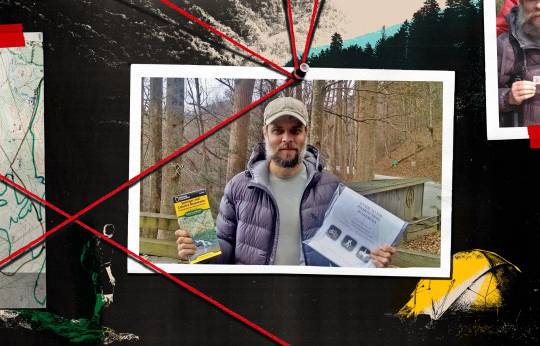
By summer, the hiker was in Virginia, where he walked about a hundred miles with a 66-year-old woman who went by the trail name Obsidian. She taught him how to make a fire, and he told her he was eager to see a bear. On December 1, Mostly Harmless had made it to northern Georgia, where he stopped in a store called Mountain Crossings. A veteran hiker named Matt Mason was working that day, and the two men started talking. Mostly Harmless said that he wanted to figure out a path down to the Florida Keys. Mason told him about a route and a map he could download to his phone. “I don’t have a phone,” Mostly Harmless replied. Describing the moment, Mason remembers thinking, “Oh, this guy’s awesome.” Everyone who goes into the woods is trying to get away from something. But few people have the commitment to cut their digital lifelines as they put on their boots.
Mason printed the 60 pages of the map and sold it to Mostly Harmless for $5 cash, which the hiker pulled from a wad of bills that Mason remembers being an inch thick. Mason loves hikers who are a little bit different, a little bit strange. He asked Mostly Harmless if he could take a picture. Mostly Harmless hesitated but then agreed. He then left the shop and went on his way. Two weeks later, Mason heard from a friend in Alabama who had seen Mostly Harmless hiking through a snowstorm. “He was out there with a smile on his face, walking south,” Mason recalls.
By the last week of January, he was in northern Florida, walking on the side of Highway 90, when a woman named Kelly Fairbanks pulled over to say hello. Fairbanks is what is known as a “trail angel,” someone who helps out through-hikers who pass near her, giving them food and access to a shower if they want. She was out looking for a different hiker when she saw Mostly Harmless. She pulled over, and they started to chat. He said that he had started in New York and was heading down to Key West. She asked if he was using the Florida Trail App, and he responded that he didn’t have a phone.
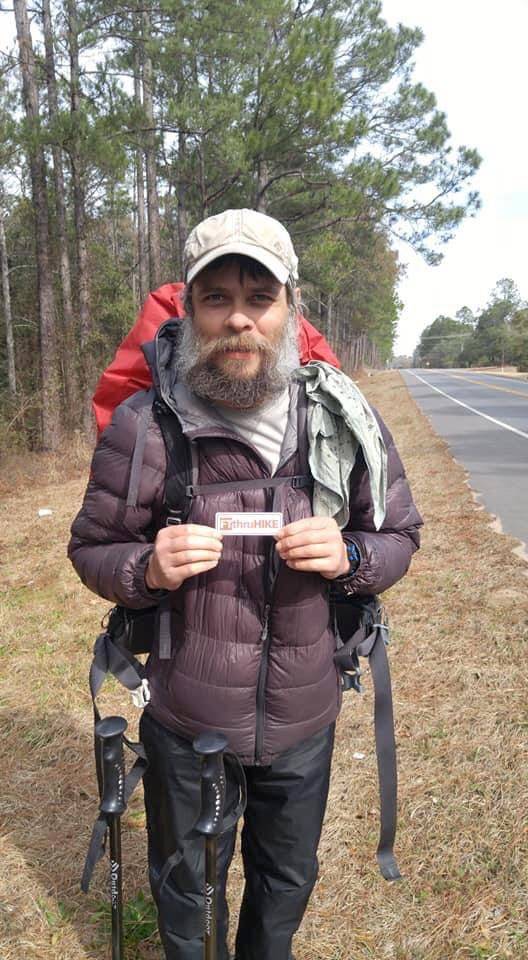
Fairbanks took notice of his gear—which was a mix of high-end and generic, including his black-and-copper trekking poles. And she was struck by his rugged, lonely look. “He had very kind eyes. I saw the huge beard first and thought, ‘It’s an older guy.’ But his eyes were so young, and he didn’t have crow's feet. I realized he was a lot younger.” She was concerned though, the way she used to be concerned about her two younger brothers. The trail could be confusing, and it wouldn’t be long before everything started getting intolerably hot and muggy. “I remembered him because I was worried,” she added.
Six months later and 600 miles south, on July 23, 2018, two hikers headed out into the Big Cypress National Preserve. The humidity was oppressive, but they trudged forward, crossing swamps, tending aching feet, and dodging the alligators and snakes. About 10 miles into their journey, they stopped to rest their feet at a place called Nobles Camp. There they saw a yellow tent and a pair of boots outside. Something smelled bad, and something seemed off. They called out, then peered through the tent’s windscreen. An emaciated, lifeless body was looking up at them. They called 911.
“Uh, we just found a dead body.”
IT’S USUALLY EASY to put a name to a corpse. There’s an ID or a credit card. There’s been a missing persons report in the area. There’s a DNA match. But the investigators in Collier County couldn’t find a thing. Mostly Harmless’ fingerprints didn’t show up in any law enforcement database. He hadn’t served in the military, and his fingerprints didn’t match those of anyone else on file. His DNA didn’t match any in the Department of Justice’s missing person database or in CODIS, the national DNA database run by the FBI. A picture of his face didn’t turn up anything in a facial recognition database. The body had no distinguishing tattoos.
Nor could investigators understand how or why he died. There were no indications of foul play, and he had more than $3,500 cash in the tent. He had food nearby, but he was hollowed out, weighing just 83 pounds on a 5'8" frame. Investigators put his age in the vague range between 35 and 50, and they couldn’t point to any abnormalities. The only substances he tested positive for were ibuprofen and an antihistamine. His cause of death, according to the autopsy report, was “undetermined.” He had, in some sense, just wasted away. But why hadn’t he tried to find help? Almost immediately, people compared Mostly Harmless to Chris McCandless, whose story was the subject of Into the Wild. McCandless, though, had been stranded in the Alaska bush, trapped by a raging river as he ran out of food. He died on a school bus, starving, desperate for help, 22 miles of wilderness separating him from a road. Mostly Harmless was just 5 miles from a major highway. He left no note, and there was no evidence that he had spent his last days calling out for help.

The investigators were stumped. To find out what had happened, they needed to learn who he was. So the Florida Department of Law Enforcement drew up an image of Mostly Harmless, and the Collier County investigators shared it with the public. In the sketch, his mouth is open wide, and his eyes too. He has a gray and black beard, with a bare patch of skin right below the mouth. His teeth, as noted in the autopsy, are perfect, suggesting he had good dental care as a child. He looks startled but also oddly pleased, as if he’s just seen a clown jump out from behind a curtain. The image started to circulate online along with other pictures from his campsite, including his tent and his hiking poles.
Kelly Fairbanks works at the Army and Air Force exchange store on a Florida military base. She normally monitors the CCTV cameras for shoplifters, but if there’s no one in the store she might sneak a look at Facebook. It was a quiet moment, and suddenly the picture popped into her feed. There he was: eyes wide open and looking up. She recognized the eyes and the beard. “I started freaking out,” she says. It was the kind man she’d seen on Highway 90. The sheriff’s office had also posted a photo of the hiker’s poles, and Fairbanks knew she had an image of the same man holding the same gear.
She clicked right over to the Collier County Sheriff’s Facebook page and sent in two photographs she had taken of Mostly Harmless. She got a message back immediately asking for her phone number. Soon a detective was on the line asking, “What can you tell me?”
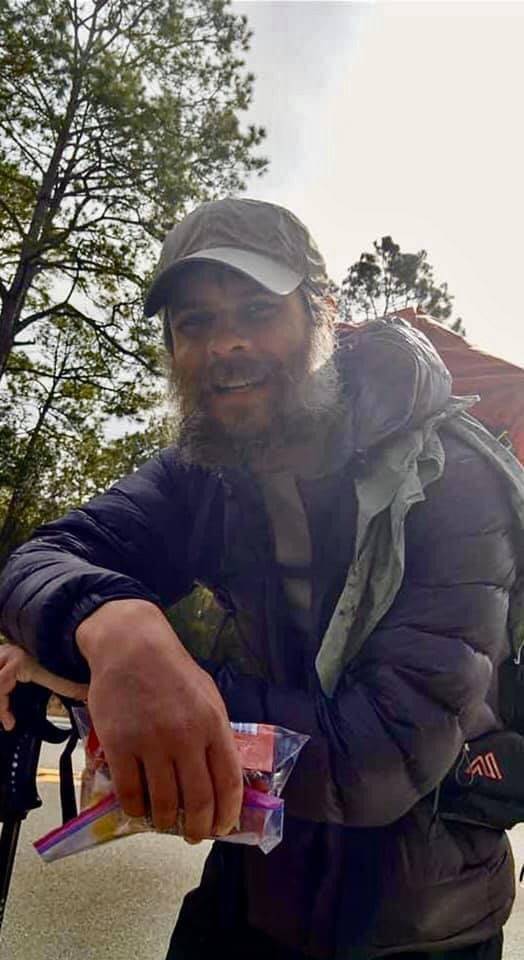
She told him everything she knew. And she shared the original post, and her photo, all over Facebook. Soon there were dozens of people jumping in. They had seen the hiker too. They had journeyed with him for a few hours or a few days. They had sat at a campfire with him. There was a GoPro video in which he appeared. People remembered him talking about a sister in either Sarasota or Saratoga. They thought he had said he was from near Baton Rouge. One person remembered that he ate a lot of sticky buns; another said that he loved ketchup. But no one knew his name. When the body of Chris McCandless was found in the wilds of Alaska in the summer of 1992 without any identification, it took authorities only two weeks to figure out his identity. A friend in South Dakota, who’d known McCandless as “Alex,” heard a discussion of the story on AM radio and called the authorities. Clues followed quickly, and McCandless’ family was soon found.
Now it’s 2020, and we have the internet. Facebook knows you’re pregnant almost before you do. Amazon knows your light bulb is going to go out right before it does. Put details on Twitter about a stolen laptop and people will track down the thief in a Manhattan bar. The internet can decode family mysteries, identify long-forgotten songs, solve murders, and, as this magazine showed a decade ago, track down almost anyone who tries to shed their digital skin. This case seemed easy.
An avid Facebook group committed to figuring out his identity soon formed. Reddit threads popped up to analyze the notes he had taken for Screeps. Amateur detectives tracked down leads and tried to match photographs in missing persons databases. A massive timeline was constructed on Websleuths.com. Was it possible, one Dr. Oz viewer asked, that Mostly Harmless was a boy featured on the show who went missing in 1982? Was it possible that Mostly Harmless was a suspect in Arkansas who had murdered his girlfriend in 2017? None of the photos matched.
The story pulled people in. Everyone, at some point, has wanted to put their phone in a garbage can and head off with a fake name and a wad of cash. Here was someone who had done it and who seemed to have so much going for him: He was kind, charming, educated. He knew how to code. And yet he had died alone in a yellow tent. Maybe he had been chased by demons and had sought an ending like this. Or maybe he had just been outmatched by the wilderness and the Florida heat.
It just wasn’t a normal story in any way. And, as Fairbanks said, “he was a good-looking dude,” which, she notes, might explain why so many of the searchers are women. In mid-October, one woman in the Facebook group posted a slideshow comparing his photos to those of Brad Pitt. “Actually I think MH looks better. 😉,” one commenter wrote.
The dude, though, seemed to have followed, to near perfection, the hiker credo of “Leave no trace.” None of the clues panned out. Nothing actually got people close to solving the mystery. An industrious writer named Jason Nark spent more than a year obsessively tracking down leads and then wrote an elegy to the hiker that began, “Sometimes I imagine him falling through space, drifting like dust from dead stars in the vast nowhere above us.”
Natasha Teasley manages a canoe and kayak company in North Carolina. As business slowed when the coronavirus hit, she started to spend more time online, and she started to fill the gap in her life with the hunt for Mostly Harmless. She sent flyers to the Chambers of Commerce in every city where people thought he might have come from, including Sarasota, Florida, and Saratoga Springs, New York. She tracked down details about every car that was towed out of Harriman State Park, where he likely started his journey. She scoured missing persons databases. I asked her what motivated her to spend so much time looking for a man she’d never met. She responded achingly, “He’s got to be missed. Someone must miss this guy.”
WHEN WE THINK of DNA tests, we normally think of their miraculous ability to give us a yes or a no. The unique thread of base pairs that make us who we are exists in every cell. So we take the genetic information found at a crime scene, or in the saliva on a coffee cup, or on the hand of a deceased hiker. Then we look closely at roughly 20 chunks, or what geneticists call markers, and we search in a database of collected samples to see whether the markers match. Imagine if a book, 1 million pages long but without a cover, washed up on the shore. And then imagine you could scan one page and search all the books in a giant database to see if that exact page appeared. That’s conventional DNA testing.
But DNA also can tell the story of human history. By running a different kind of test, you get beyond yes or no and into a million variations of maybe. The genetic markers in your body are closer to those of your first cousin than your third. And they’re closer to those of your third cousin than your sixth. There’s a little bit of each generation in each of us, from our parents to our great grandparents to the early apes of the forests of Africa. So now imagine that book, and imagine that instead of comparing one page, you could compare everything in the book with everything in all other books, to find similar words, syntax, and themes. You would need complicated math and pattern tracing, but, eventually, you might figure out the author. And so, early in the summer of 2020, the organizers of the Facebook group searching for Mostly Harmless’ identity sent news about the case to a Houston company called Othram. It had been started two years earlier and pitches itself as a one-stop shop for solving cold cases.
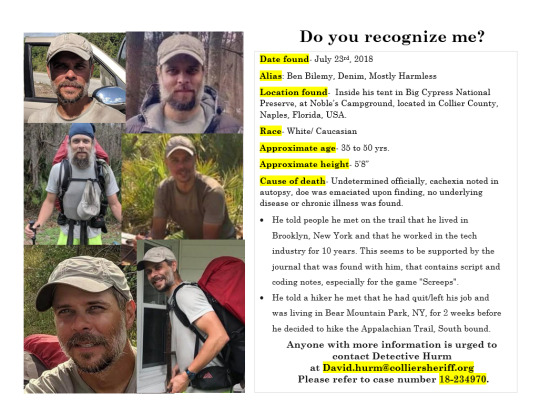
Othram’s founder, David Mittelman, is a geneticist who had worked on the original human genome project, and he was drawn to this odd case. The company asks the public for suggestions for mysteries to solve, and that’s one of the best parts of the job. “I like doing the cases from the tip line,” Mittelman told me. “Lab work for the sake of lab work is kind of boring.” If he could crack the hiker’s identity, he’d get attention for his technology. But there was something else, too, drawing him in, a riddle he wanted to answer. The hiker seemed to have found an internet family but had no connection to his real one.
Othram called up the Collier County Sheriff’s Office and offered to help. DNA analysis is expensive, though, and the company estimated that the whole project—from evidence to answers—would cost $5,000. The sheriff's office couldn't spend that much money on a case that involved no crime. But it would love Othram’s help if there were another way to pay for the work. And so three of the great trends of modern technology—crowdfunding, amateur sleuthing, and cutting-edge genomics—combined. Within eight days, the Facebook group had raised the money to run the analysis. Soon a small piece of bone from the hiker was on its way west from Collier County to the Othram labs.
The first step for Othram’s team was to extract DNA from the bone fragment and to then analyze it to make sure they had enough to proceed. They did, and so they soon put small samples of DNA onto glass slides, which they inserted into a sequencer, a machine that costs roughly a million dollars and looks like a giant washing machine made by Apple.
Unfortunately, it’s a washing machine that has a long run cycle. And it doesn’t always work. Sometimes the pages of the book you find are ripped or blurry. Sometimes the process is iterative and you have to tape fragments back together. So, as the sequencer spun, the Facebook hunters fretted that, once again, nothing would come of a promising lead. But by mid-August, Othram had a clean read on the DNA: They knew exactly what combination of As, Cs, Gs, and Ts had combined to create the mysterious hiker. A company spokesperson appeared live on the Facebook group’s page to detail the progress; posters responded with gratitude and euphoria.
Science sometimes gets harder with every step, though, and having the sequence was just the beginning. In order to identify Mostly Harmless, the team at Othram would have to compare his genetic information with other people’s. And they would start with a service called GEDMatch, a database of DNA samples that people have submitted, voluntarily, to answer their own hopes and questions—they want to find a lost half-sister or a clue about their grandpa. That collection of DNA has become a cornucopia for law enforcement. Each new sample submitted provides one more book for the library that can be searched and scoured. It was through this technique that investigators in Contra Costa County, California, found the Golden State Killer in the spring of 2018, connecting a DNA sample of the killer to GEDMatch samples of relatives. Just this past week, Othram helped law enforcement identify the murderer of a 5-year-old in Missoula, Montana, a case that had gone unsolved for 46 years.
It’s been over a month since Othram started looking through the GEDmatch database. It won’t say anything about what it has found, and the Collier County Sheriff’s Office is keeping quiet as well. But one source outside of the company who is familiar with its progress says that, while Othram doesn’t know Mostly Harmless’ name, it has found enough matching patterns to identify the region of the country from which his ancestors hail.
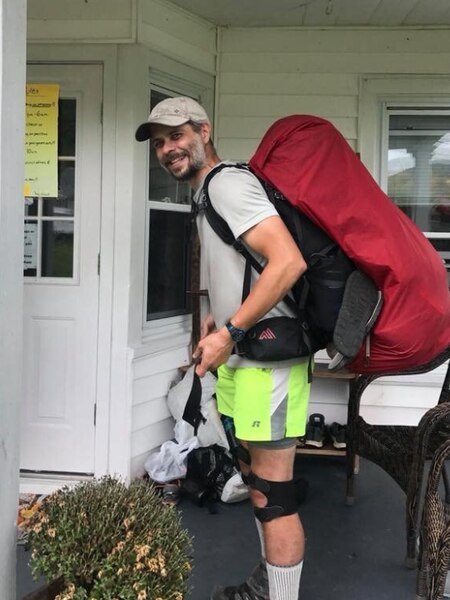
That isn’t sufficient though. Knowing for sure, for example, that his relatives came from Baton Rouge doesn’t mean Mostly Harmless came from Baton Rouge. His parents could have been born there and moved to Montreal. He could have been born in Louisiana and dropped on a doorstep in Maine. But, right now, the data scientists at Othram are combing through all the DNA samples in GEDMatch, looking for patterns and trying to circle closer to his identity. They’re most likely building out a family tree. Let’s say they found someone in GEDMatch whose DNA seems like a fourth cousin of Mostly Harmless, and then perhaps someone who seems like a third cousin. How do those two people connect? Through this sort of slow, painstaking analysis, they can get closer to an answer. Soon they might find his extended family, and then perhaps his parents’ names. And then law enforcement will be able to solve a case that has stumped them for more than two years.
They might get there, and they might not. A source familiar with the work suggests that the earliest we’ll get an answer is December. Unless between now and then, perhaps, someone reading this article or browsing a Facebook group recognizes his face. Or puts together clues that have eluded everyone else. Finally, he won’t be “Mostly Harmless”; he’ll have a real name.
And then, with that mystery solved, a new one will open up. Why did Mostly Harmless walk into the woods? And why, when things started to go wrong, didn’t he walk out?
3 notes
·
View notes
Text
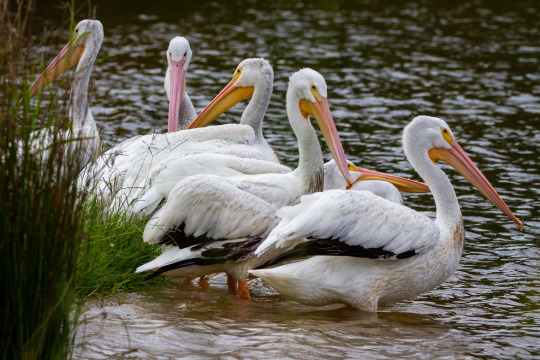

A flock of American White Pelicans, Cypress Point Public Use Area, Ellzey Rd, Sardis, Mississippi, USA
Joshua J. Cotten
Scientific name: Pelecanus erythrorhynchos
Mass: 14 lbs (Adult)
Conservation status: Least Concern (Population increasing)
Class: Aves
Domain: Eukaryota
Family: Pelecanidae
Genus: Pelecanus
The American white pelican is a large aquatic soaring bird from the order Pelecaniformes. It breeds in interior North America, moving south and to the coasts, as far as Costa Rica, in winter.
#Cypress Point Public Use Area#Ellzey Rd#Sardis#Mississippi#USA#US#United States#United States of America#North America#MSWildlife#Wildlife#American White Pelicans#Pelican#Birds#Bird#American White Pelican
2 notes
·
View notes
Text
Marine Biology Story of the Day #11
Hello followers. Today we are going to talk about a very special period of my life that really drove my interests, opened up doors for me, and gave me a lot of confidence that what I had chosen to do with my life was my calling.
When I was in college, during both my undergrad and my graduate degree, I worked at a small aquarium. To my young budding marine biologist brain, it was a dream job. In many ways, it still is a dream job, and I’m glad I got the opportunity to have this experience.
The aquarium I worked for is the Virginia Living Museum, a small, not well known, but somehow magical place tucked into the Newport News woods. You might know us from our virial photo of an albino catfish with a binky in it’s mouth—it went viral a couple of years ago. Yep, that was us.

Not only are there aquarium exhibits, but there were also reptiles and mammals as well, including a huge outdoor trail where you could see wolves, deer, water birds, otters, etc. One of the really unique aspects of this museum was that almost all of the animals found here were Virginia native species, and therefore were either animals that needed care or rehabilitation, or, in our case, were caught in VA waters and hopefully eventually released.

So I originally started volunteering at the VLM at the touch tank, and then I got an opportunity to volunteer for the aquarium department, and then, eventually, around my Junior year, I was offered a part time position as an aquarist. I dove into the experience, and the chaos.
Our aquarium department was small, but we did have a lot of exhibits to take care of, ranging from a 30,000 gallon salt water aquarium, to our “habitariums” which were large freshwater exhibits built to mimic natural ecosystems in Virginia, the cypress swamp and a mountain river. We also had much smaller exhibits—some of the smallest being no more than 30 gallons, housing juvenile marine fish, dwarf sunfish, and blind cavefish.
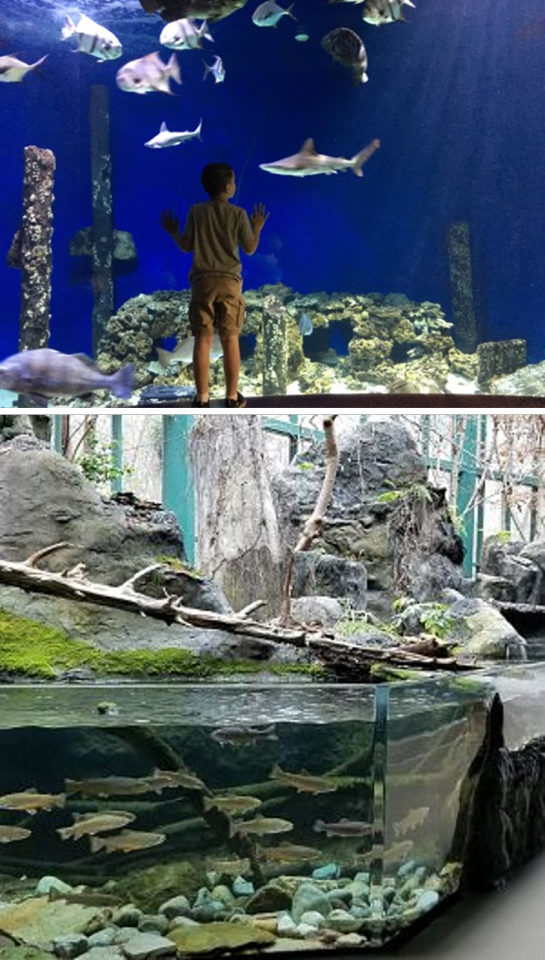
(our Chesapeake Bay Aquarium (above) and our Mountain Cove Habitarium (below))
We were taking care of these animals 24/7, holidays, snow days, weekends. A typical day included getting in and feeding all of the exhibits, and then doing food prep for the next day. We would feed our fish a variety of seafood products, cut up depending on their size and biology—squid, shrimp, scallops, herring, capelin, smelt, mysid shrimp, to name a few. Then, we would get to work on some water changes—this would involve replacing out 10-50% of the water in an exhibit with new “fresh” water (meaning new water to the tank, not necessarily fresh as many of our tanks were salt water). When you have biomass in a system (meaning fish, crabs, plants, etc.), these animals release excrement, and bacteria breaking down this waste can release ammonia and nitrates into the water, which can eventually kill fish at high levels, so it is important to exchange water weekly. In addition, we would scrub algae from rocks and the tank glass, and use a “gravel washer” or a siphon vacuum to suck up un eaten food and waste that gets trapped in the sand or gravel substrate. We would do 6-7 of these a day, depending on a rotating schedule.
Now, with the bigger tanks, this meant getting in them in order to clean them. We would either snorkel or dive, depending on the depth, and so I got my open water dive certification as soon as I could. My absolute favorite was diving the Chesapeake Bay Aquarium.

Now, along with all of our public exhibits, we had a set of quarantine tanks as well. A quarantine tank, in the terms of a public aquarium setting, is a place were we can acclimate new fish to tank life. It allows them to become comfortable with feeding in an aquarium, it gives us time to treat them for potential diseases, and allows the individuals to be as healthy as possible before they get put on exhibit. We had quarantine tanks for everything—from racks of small 20 gallon fresh water or salt water tanks for juvenile fish, to huge industrial tubs for sharks and turtles.

Some of our fish in quarantine: Juvenile Atlantic Spadefish (top left), Juvenile Smallmouth Bass (top right), Juvenile Black Drum (Mid left), very teeny tiny baby Atlantic Spade fish (mid right), Two of our juvenile Sandbar Sharks (bottom left), a very small (5 in) clearnose skate (bottom right).
These were often some of my favorite tanks because they were constantly changing out—we were constantly getting new fish and it was always exciting to see new species. It also gave me a chance to get really good at fish identification—including juvenile fish. Juvenile fish often have much different coloration and even physiology than the adults, so this has helped me in my marine biology career.
This job gave me a lot of cool experiences, but I’m going to give a brief talk about three of our programs that were some of my favorites, and that I got to work on. I may elaborate these in more detail in later posts, but for now, I’ll give brief overviews.
The first project that we were heavily involved in was the North Carolina Aquarium Sea Turtle program. We would receive young juvenile loggerhead turtles, many of which would become stranded on beaches during the winter months, and care for them, have them on exhibit, but also, feed them and allow them to grow and be healthy. Then, once the turtles got too big for the tank, or at a certain weight, we would release them, with a tag, back into the Atlantic Ocean. I went through 3 turtles while I worked at the VLM, we would get about one a year. It was a fun, sometimes frustrating, and rewarding experience to work with this beautiful (albeit, dumb-as-a-rock) animals and see them released into the wild.

(Top: One of our adult turtles on exhibit, bottom: one of our turtles getting a 6 month check up, right: juvenile turtle in quarantine, getting ready to go on exhibit)
Another program that I loved was our Sea Horse Breeding Program. Sea Horses are notoriously hard to keep in captivity as they are extremely sensitive to contaminants in the water and environmental changes. Breeding them is even more difficult—the babies, when they are released from the dad’s “pocket” are no larger than an eyelash, and even in perfect condition, sea horse babies have a 90% mortality rate. Our little aquarium had the most successful lined seahorse breeding program on the east coast, we would regularly get baby seahorses to survive into adulthood—and this was mostly thanks to our aquarium curator, my boss. We also managed to bring in new DNA into the Sea Horse scene by introducing wild-caught seahorses into our breeding population, only increasing our success. Chances are, if you’ve been to an aquarium on the East Coast, you’ve seen our sea horses.

(Some macro pictures of newborn seahorses--reminder, these fish are no bigger than an eyelash. The white dots surrounding them are newborn brine shrimp their food)
Okay, last project I worked on while I was there was our coral reef tank. Now, I know I said before that most of the exhibits held only Virginia native species---well that was true, except for this exhibit. This exhibit was supposed to represent prehistoric Virginia—as at one point, millions of years ago, Virginia was covered by a warm, shallow, inland sea—and so a coral reef is the closest we could get to representing that environment. I bugged, and bugged, and bugged my boss to teach me about it, to let me re-do the tank, because at the time it was pretty bare of coral, and wasn’t doing great. He agreed, and together we rebuilt the exhibit—this whole saga probably needs it’s own post. We drained the entire tank, added calcium and magnesium treatments, added new corals from the Mote Marine Laboratory down in Florida, and slowly but surely, created a beautiful exhibit.
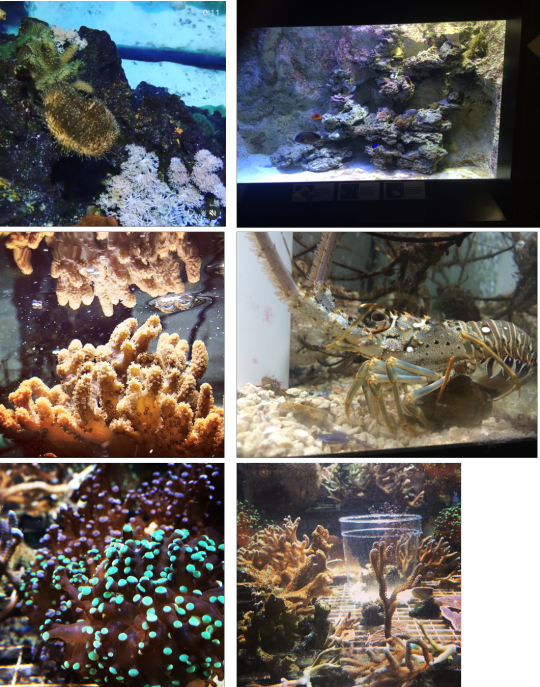
(Top left: finished coral exhibit from above, top right: tank from the front, during our re-build, mid left: xenia coral in quarantine, mid right: spiny lobster in quarantine, bottom left: frogspawn coral in quarantine, bottom right: a shot of our quarantine tank after taking a trip down to Mote Marine Lab in Florida.)
Overall, this was a great experience for me, and I will probably do more posts on it, but I eventually left, because…weirdly enough, it got monotonous. I think aquariums are great for public education, but I wanted to do more, I wanted to answer questions and solve problems, I wanted my work to impact my world on a bigger scale. But I will never forget how this place shaped my young career—and I am still, always very excited to go to an aquarium, and I don’t think that is something that will ever change for me.
Now, because of this pandemic, the VLM had to let a lot of their staff go. They are non-profit, and therefore do not have a lot of back up funds to keep the museum running. They are still open now at low capacity—so if you are in the area, feel free to visit (with a mask of course) and if you are interested, you can donate to this little-museum-that-could here. And, you can read more about the workings and the past experiences of the aquarium department here, it’s a blog run by my former boss.
Thanks for listening, and as always if you have questions about my experiences or about the animals we housed, PLEASE do not hesitate to ask or comment.
#marine biology stories#marine biology#marine biology story of the day#virginia living museum#VLM#aquarist#aquarium#aquarium stories#aquarist stories#ocean stories#coral#coral reef tanks#sea turtle#sea horse
3 notes
·
View notes
Text
Hair and makeup by Tree Vaello
Growing up, I never realized how important my English classes were. I remember giving away my copy of George Orwell's "Animal Farm" to a beautiful girl named Elizabeth. Now, we all live in Orwell's world, and when the President of the United States of America says "terrorist hate us for our freedoms[6]," what he really means is he and global oligarchy hate American citizens for their freedoms, and they'll stage any number of "terror attacks" necessary in order to remove each and every freedom there once was..
wholesale jerseys from china Football brings countries together. Football is part of people's lives. Admittedly I see a lot of inter racial hugging and camaraderie on the pitch too. Under new rules being proposed by the Rugby League International Federation (RLIF), players not selected for the so called tier one nations, Australia, cheap nfl jerseys New Zealand and England, will be free to play for developing league countries. It means the likes of Jarryd Hayne and Anthony Milford could each play State of Origin next year, before being selected to play for Fiji and Samoa respectively at the end of season World Cup. And then backflip again to play for Australia.. wholesale jerseys from china
Cheap Jerseys from china Kenneth A. Vercammen is a Middlesex County trial attorney who has published 125 articles in national and New Jersey publications on litigation topics. He has been selected to lecture to trial lawyers by the American Bar Association, New Jersey State Bar Association and Middlesex County Bar Association. Cheap Jerseys from china
nfl jerseys Those fans looking to make the trip to see the team in action, there are a couple of options but they're pricey. The Ticats have secured a limited allotment of Grey Cup tickets behind the Ticats bench, no less which can be purchased for $403. https://www.wholesalejerseyslan.com/ But flights and accommodations are not included and both will be hard to come by.. nfl jerseys
wholesale nfl jerseys from china The money enables tribe people to buy necessities they cannot make or grow themselves. It also enables them to buy Poplar Creek concert tickets, which, in turn, allow the tribes to replenish the stock of concert T shirts and jerseys that serve as protective coloration. While warm weather offers a gentle, bucolic existence, winter is a very difficult time for the tribes, who subsist on whatever stock is in their food larders and rely on the shelter of makeshift huts. wholesale nfl jerseys from china
Cheap Jerseys china 1430: GOLD for Canada's Ashleigh McIvor in the women's ski cross. BBC commentator Graham Bell says: "It's been a happy hunting ground Cypress for Canada." nfl jerseys And he's not wrong as Alexandre Bilodeau won the moguls gold there and local lady Maelle Ricker triumphed in the snowboard cross. That's six golds now for the host nation. Cheap Jerseys china
cheap nfl jerseys "For the fans to go out and vote, I definitely have to give it to them," Schimmel told reporters after being named an All Star. "For them to have my back and sit there and vote for me every day is just something they took pride in. They obviously want to see me in the game, so for them to do that means a lot to me.". cheap nfl jerseys
wholesale nfl jerseys But there are various kinds of dresses and skirts with various styles and colors. http://www.okcheapjerseys.com/ How do you select one perfect for you? Do you want to be a very different and special woman? Here I want to say that there is a plenty of knowledge about skirt you should learn. I suggest you that slit skirt can help you meet your expectation. wholesale nfl jerseys
wholesale nfl jerseys Crime is everywhere. Crime against persons and property has gotten to the point where individuals need to learn how to protect themselves and their families. The police just can t do it all. Hair and makeup by Tree Vaello. ( Smiley N. Model: Carly Adams, Neal Hamil Agency. wholesale nfl jerseys
wholesale nfl jerseys from china SubscriptionsGo to the Subscriptions Centre to manage your:My ProfileAli, a permanent resident of Canada, will be held in custody until his next court appearance on Friday, when he will be assisted by a Somali interpreter. His defence attorney also asked that Ali be assessed by a doctor. wholesale jerseys from china The RCMP said Wednesday that the investigation is continuing, but added that there is no reason to believe the incident was politically motivated, or an attempted terrorist attack."I understand it is less a concern around so called national security considerations than it is a mental health issue," RCMP Commissioner Bob Paulson told reporters Wednesday. "There's a history of behaviours that are odd.
"We'll see more details as we go along but the best information that we have right now is that it's mental health, bad judgment, a crazy behaviour issue," Paulson said.Meat cleaver tucked in pantsSources have told CBC News that on Tuesday, Ali obtained a tour ticket from the parliamentary visitor centre on Wellington Street, and then entered Centre Block through the public entrance at the base of the building.Security guards asked a man to remove his overcoat as he was about to pass through the metal detector.The man reluctantly opened his coat, at which time the guards spotted a large meat cleaver tucked into the waist of his pants.Ali has no known connection to the Ottawa area. wholesale nfl jerseys from china
nfl jerseys Vowed to follow God with his whole heart. He did. The end, he put his trust in Our Father, and went to be with God in heaven. Rear derailleurs are classified in the same manner as front derailleurs first by speed: 8/9/10, then by double or triple (it is actually the difference between the largest and smallest chainring added to the difference between your largest and smallest cog). Typically, https://www.cheapjerseys18.com/ with a double chainring you can use a short cage and with a triple you would need a long cage. The longer cage helps take up the extra slack that appears when in the small ring nfl jerseys.
1 note
·
View note
Text
One thing led to another

#One thing led to another plus#
#One thing led to another series#
#One thing led to another free#
Electronic Health Records Health Information Exchange Logical Observation Identifiers Names Codes RxNorm Systematized Nomenclature of Medicine U.S. terminology standards for electronic health records.ĭonald A.B. This chapter describes key factors in the transformation of NLM into a significant player in the establishment of U.S. electronic health records (EHRs), and the provider of many services and tools to support the use of terminology standards in health care, public health, and research.
#One thing led to another free#
Department of Health and Human Services, a major funder of ongoing maintenance and free dissemination of clinical terminology standards required for use in U.S. Lindberg retired in 2015, NLM was the Central Coordinating Body for Clinical Terminology Standards within the U.S. National Library of Medicine (NLM) was a leader in the development and use of information standards for published literature but had no involvement with standards for clinical data. The Wilderness Systems Commander 140 has served me well in my young duck hunting career and it will continue to be my platform of choice for seasons to come.When Donald A.B. As it often happens, “one thing led to another” and two of my most passionate activities in life fused into one, and a duck hunter was born. I have been hunting most of my life and fishing out of a kayak for a number of years now, the combination of woods and water just makes sense. With minimal cover I have been able to stay inside my kayak and shoot birds over decoys, the Commander is also so stable I am able to swing on passing birds with ease. There have been occasions when water levels have risen to the point where wading is no longer an option and when I find myself in these situations I have simply stayed in the Commander, the ducks don’t seem to mind. During most of my hunts I paddle to the area I want to hunt, drag the kayak up the bank into some brush, and then wade flooded timber or I will utilize brush blinds.
#One thing led to another plus#
With all of these features plus surprising speed and no snag prone scupper holes, there are very few places for the ducks to feel safe. The SlideTrax system that runs nearly bow to stern is exceptionally convenient for ensuring a custom fit while securing precious cargo like a shotgun. The beauty of the SlideTrax system is the movable mounts that can be made to accept bungee cord or cam-buckle straps for even more confidence when transporting valuable outdoor gear.
#One thing led to another series#
Another virtue by design the Commander series has is they are the equivalent of a pickup truck. With a high weight capacity and an open design just about any piece of gear simply gets loaded up and tied down as easily as loading your truck bed.īungee cord in the stern tankwell is suitable for securing crates or dry storage boxes. This camo scheme is a reboot of the original camo colors offered by Wilderness Systems and feature darker greens, earth tones and subdued logos. This kayak really does a great job of disappearing while hugging the banks of a tree-lined creek or sneaking through a cypress swamp. When I ordered my Commander 140 I chose the camo color scheme not only because the kayak looks great but also I had hopes of one day using this kayak for some sort of hunting. From never having had sex to your twentieth time, sex can be. In the end, one thing always leads to another. I quickly realized that getting started was not going to be that hard because I already had a shotgun, some camouflage and most importantly a Wilderness Systems Commander 140. No matter the reference or outcome, it all starts in the same place. A few hundred carefree ducks feeding and splashing in a secluded back water bayou looked like a hanging curveball to me, and I knew I’d have to take a swing. Our hunt had ended and the mid morning sun revealed what had to have been a few hundred gadwall that had flown into a nearby bayou.Īnyone who has spent any amount of time hunting game knows a few things, chief among these: Adapt to changing conditions and take advantage when an opportunity presents itself. It was not due to a lack of ducks and geese in our area, being close to the eastern flyway kept a constant supply of mallards and Canadian geese passing through.įast forward to January 2014, my four-year-old son was accompanying me on his first squirrel hunt on the wildlife reservation on Barksdale Air Force Base. This wildlife reserve is 18,000 acres situated next to subdivisions, shopping centers and an interstate highway a literal wildlife oasis amid urban sprawl. Waterfowl hunting, however, never appealed to me in my younger years. This is the exact phrase I would use to describe how my waterfowl-hunting career got its start. Like many sportsmen, I grew up hunting squirrels and rabbits along with the prolific Pennsylvania Whistle Pig, known more commonly as the ground hog. As I matured, pheasants and whitetail were added to my list of targeted species.

0 notes
Text
Journal 2
University Sustainability & Campus Trails Field Trip
This past Tuesday, September 13th, We went on our very first field trip for my Colloquium class! It was so much fun. We explored all around campus... Our first stop was at the Veterans Pavilion. We talked about what happens here- important speeches are given, emotions are shared, art is displayed, and ceremonies and cultural events are held here. Veterans Pavilion is at the heart of campus and is our university's sense of place.
The second stop was inside Seidler Hall. This building has been appointed as being LEED platinum. This high status of energy efficiency is achieved through methods such as motion-triggered lighting, solar-powered electricity, and accessible showers for public use to encourage physical means of transportation. Some benefits of being LEED accredited include boosting public image, tax benefits, improved employment, better employee performance, and an overall healthier environment.

Our next third stop was just outside the neighboring building, Whitaker Hall. Our campus naturalist guide, Paige, pointed out a few sustainable components that we use each day... the solar-powered self-compacting trash cans and recycling containers, as well as the type of walkways that were chosen. The sidewalks are made of pavers that function with the rainfall as they absorb the water, filter it and release it to the drainage ponds, helping to passively maintain healthy water on campus.
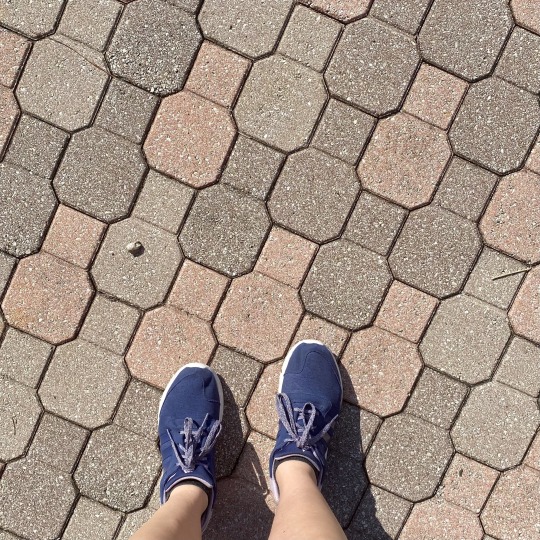

Our fourth and final stop on the main campus was at the AC cooling plant. This is a very important component of campus sustainability. These tanks function to push cool air throughout the academic buildings throughout the day on a time system in sync with the day's time and the temperature outside to maximize efficiency. The tanks are full of frozen blocks of water, and the ice is melted and turned into vapor to supply the fresh cool air in our classrooms.
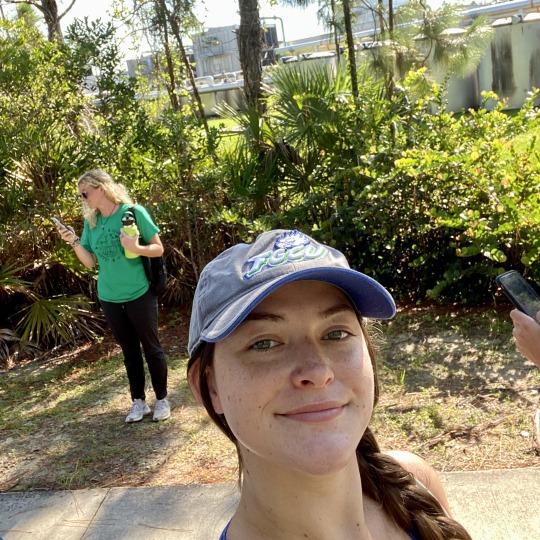
Moving onto the campus trails portion of the field trip...
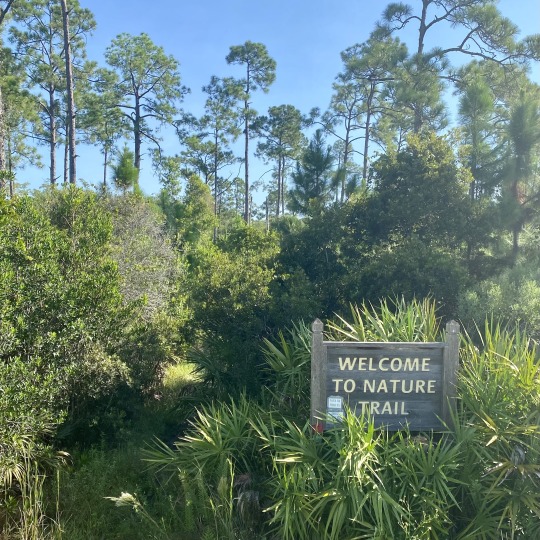
We walked the trail that lies between the arts and music portion of campus and the SOVI student living facilities.
When we first entered, we were amongst what is known as the pine flatlands. This area, and others with a similar ecosystem will be managed with prescribed fires to help build fire retardant abilities. As you approach an area as such, you will notice various plant life that is blackened and charred, creating a metaphorical callous of resilience.

The second area that we entered was the Oak Hammock. You could notice the transition from the pine flatland to here by the lowered temperature. The canopy coverage of the broader branched trees cooled the climate in this environment nicely.
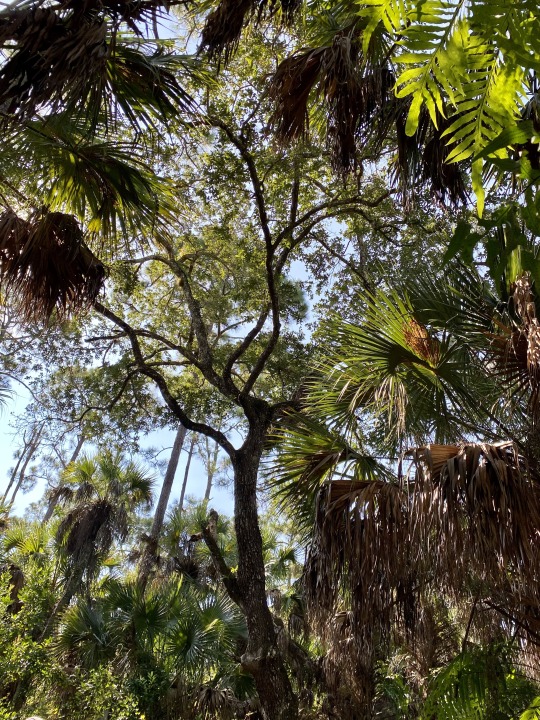
Within the Oak Hammock, I found some very cool air plants living on the trees.

I also came across some lovely Beauty Berries, and a pretty little pink flower and tucked it in my braid!


Once we started to get wet, we knew that we had entered the Freshwater Marsh portion of the trail. This water reached up to be about mid-shin deep.
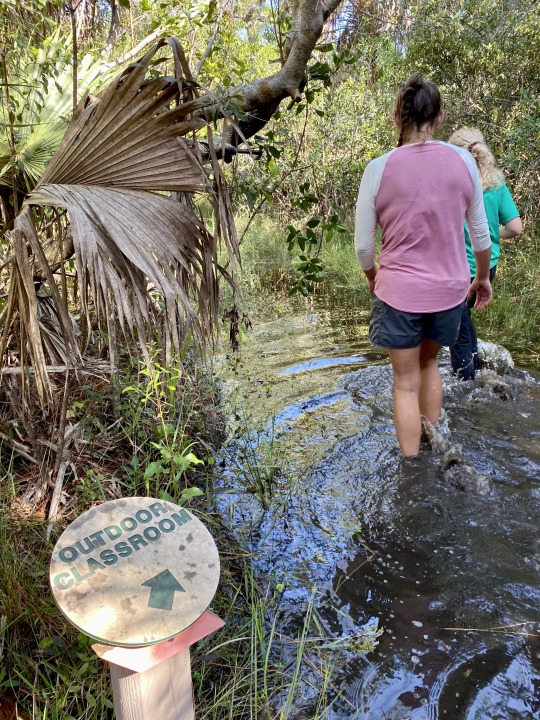
A unique form of plant life found here is known as the Alligator Flag. It lines the waterways in marshes, where alligators will live. People named this plant because it would wiggle and move when an alligator approached through the plants.
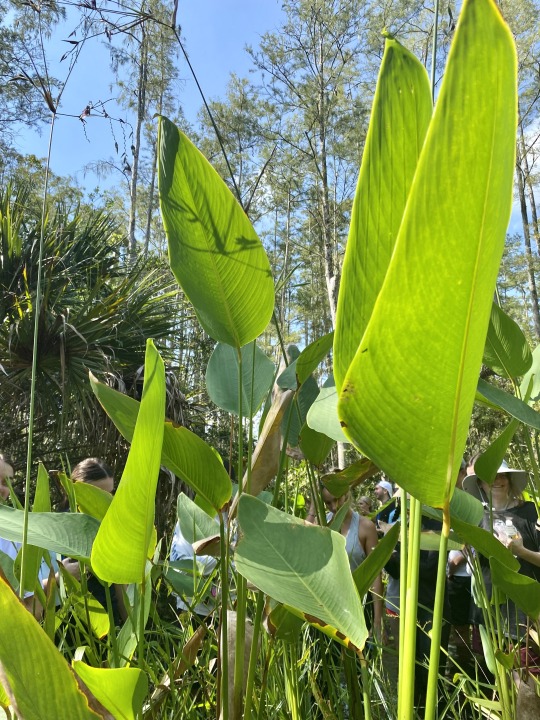
I captured this perfect flower floating in the marshy water- looking so delicate and peaceful.
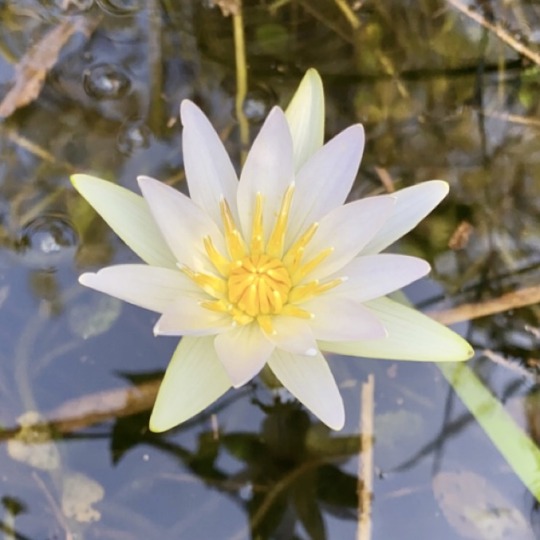
Our final destination was the Cypress Dome. This was waist-deep water. Considering how hot it is outside, I was pleasantly surprised by how cool the water was. It was very refreshing.

We were asked to pick a tree and be still with it. Observe our surroundings and just be here. This was a magical experience, to say the least. To be standing amongst super tall trees in water covering half my body! I think some classmates found this to be bizarre, but everyone in the end found appreciation for the moment.

I felt grateful.
Grateful for the opportunity, for the weather, for my teacher, for the naturalist guide, and for none of my classmates screaming at the bugs and having to get wet.
Most importantly, I felt grateful for nature allowing such a perfect moment to exist.
We are blessed.
Grace
0 notes
Photo
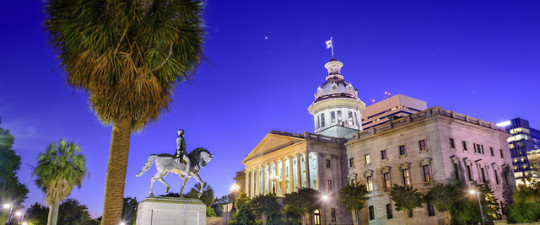





Moving To Columbia South Carolina
Columbia, SC, is known for being "famously hot," with summer temperatures matching the enormous number of fun things to do in South Carolina's capital city. Whether you're headed to town on business or to drop off your college freshman at the University of South Carolina, here are 10 things to know about the new Southern hot spot so you'll fit right in. Columbia is the first city in the US named for Christopher Columbus. The name Columbia won over the other popular option, Washington.
The Soda City was founded in 1786, but you won’t see many 18th or early-19th century buildings there. That’s because two-thirds of Columbia burned to the ground during the Civil War when Gen. William T. Sherman entered the city in 1865.
Not only is Columbia the state capital, it is also South Carolina’s largest city. The 2012 census reports 131,686 residents within the city limits and 784,785 residents in the surrounding metro area. Columbia is located 13 miles away from the geographic center of South Carolina and situated on the fall line of the Congaree River. The city’s official nickname is “The Capital of Southern Hospitality.” According to areavibes.com, the cost of living in Columbia is 8.9% lower than the national average, which makes Columbia a very affordable city to live in.
Columbia is home to South Carolina’s largest university – the University of South Carolina. The school is a major player in the Southeastern Conference of NCAA sports with three conference titles. The university is also one of the city’s largest employers along with the South Carolina state government, Palmetto Health, and Blue Cross Blue Shield of SC. Major manufacturing facilities in the area include Michelin, Trane, and Bose Corporation. Columbia’s modern business landscape is quite different from the city’s early economic success and growth, which primarily came from the cotton industry.
Midlands Technical College - Midlands Tech is part of the South Carolina Technical College System It is a two-year, comprehensive, public, community college, offering a wide variety of programs in career education, four-year college-transfer options, and continuing education.
Public education in South Carolina has recently composed a state-wide goal known as the 2010 SC Performance Goal, in which all districts will strive to make South Carolina's students achievements rank in the top half of the US. Various programs like the District Open Enrollment, which affords parents the opportunity to enroll their child in any public school in a district, regardless of assigned attendance zone, the Virtual School Program, which allows more students the opportunity to take AP courses when they may not have otherwise been able to, and the Personal Pathway to Success, which allows and makes a student's education relevant to their aspirations and abilities, have been constructed in an effort to make a better economy and quality of life for everyone in South Carolina.
The Columbia Metropolitan Convention Center, which opened in September 2004 as South Carolina's only downtown convention center, 40 is a 142,500-square-foot (13,240 m2), modern, state-of-the-art facility designed to host a variety of meetings and conventions. The main exhibit hall contains almost 25,000 square feet (2,300 m2) of space; the Columbia Ballroom over 18,000 square feet (1,700 m2); and the five meeting rooms ranging in size from 1500 to 4,000 square feet (400 m2) add another 15,000 square feet (1,400 m2) of space.
Fort Sumter: The fort was annexed into the city in the fall of 1968, with approval from the Pentagon In the early 1940s, shortly after the attacks on Pearl Harbor which began America's involvement in World War II , Lt. Colonel Jimmy Doolittle and his group of now-famous pilots began training for the Doolittle Raid over Tokyo at what is now Columbia Metropolitan Airport 10 They trained in B-25 Mitchell bombers, the same model as the plane that now rests at Columbia's Owens Field in the Curtiss-Wright hangar.
Points of interest include Fort Sumter National Monument, Fort Moultrie, Fort Johnson, and aircraft carrier USS Yorktown in Charleston Harbor; the Middleton, Magnolia, and Cypress Gardens in Charleston; Cowpens National Battlefield; the Hilton Head resorts; and the Riverbanks Zoo and Botanical Garden in Columbia.
The historic Congaree Vista , a 1,200-acre (5 km2) district running from the central business district toward the Congaree River, features a number of historic buildings that have been rehabilitated since its revitalization begun in the late 1980s.
Not the kind of shagging that Austin Powers was talking about… The 'Carolina Shag' is a partner dance born in South Carolina This mixture of the jitterbug and swing dancing is a lot of fun and not too hard to learn—especially since South Carolinians practically learn it before they learn to walk.
Kiplinger Magazine recently named Columbia one of the “10 Great Cities to Live In.” Columbia has also been named a top mid-sized market in the nation for relocating families. You don’t have to go far to rub shoulders with celebrities, either. Columbia is home to a number of famous artists and athletes, as well as musicians including: Hootie and the Blowfish, Band of Horses, Samuel Beam (better known as Iron & Wine), and Rob Thomas of Matchbox Twenty.
As a result of its central location, comfortable lifestyle and temperate climate, Columbia enjoys a robust economy and was ranked 14th in BusinessWeek Magazine's list of "40 Strongest Metro Areas" in both 2009 and 2010. Columbia ranks in the top 25th percentile, nationwide, among the 366 metropolitan statistical areas (MSA) designated by the U.S. Census Bureau, and first in economic strength in South Carolina.
Columbia has a diversified economy that includes major employers such as Palmetto Health hospital system; Blue Cross Blue Shield of SC and its subsidiary, Palmetto GBA; the University of South Carolina; and the southeastern hub of United Parcel Service. There are 70 foreign affiliated companies in the region and fourteen Fortune 500 companies here including the corporate headquarters of SCANA.
The City of Columbia has also won an award from The International Downtown Association for its rehabilitation and adaptive reuse of historical buildings in the historic Congaree Vista, a 1,200-acre district running from the central business district toward the Congaree River. This area, until recently, was a visual blight to the entrance of downtown resulting from business closures or relocations to the suburbs. But, historic buildings now house art galleries, restaurants, unique shops, museums and professional office space while still retaining the historical perspective.
Columbia South Carolina has always had a lure about it and that lure as only grown in recent years. Its a great place to raise a family and has seen many family's relocating their. Make sure you look for good Long Distance Moving Companies to handle your relocation to Columbia South Carolina.
3 notes
·
View notes
Text
Japanese bath house research

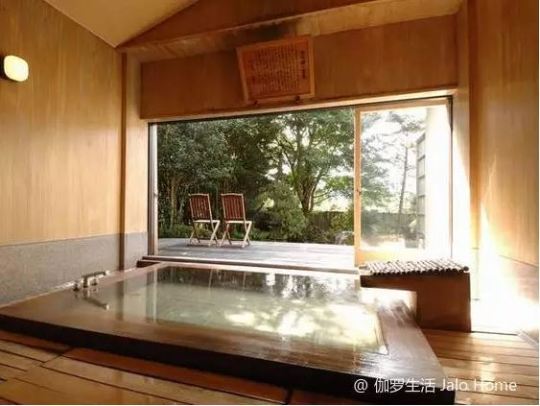


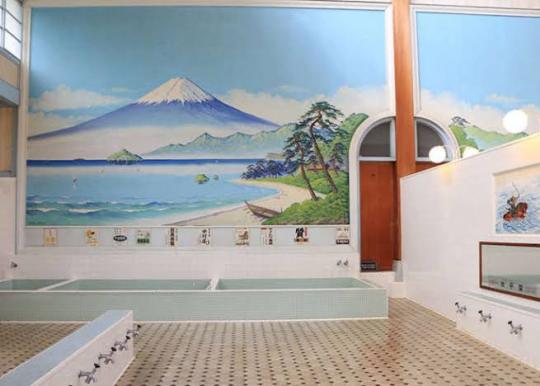



The Japanese bathing culture was introduced to Japan with Buddhism. After a thousand years to the Edo period in the 17th century, the general public began to enjoy hot springs. While soaking in hot springs to rest and socialize, it became a popular way of life for people at that time. Japanese bathrooms are generally small, complete with internal organs, reasonable use of space, and complete facilities. Today's Japanese not only have bathrooms for daily bathing, but also often choose to go to hot springs as their main leisure activity. The bathing culture is also gradually reflected in the animation of Japanese popular culture. In Hayao Miyazaki's "Spirited Away", the entire story scene takes place in a Japanese-style bathhouse. "Spirited Away" by Hayao Miyazaki
A typical Japanese bathroom consists of a shower and a bathtub. In Japan, it is rare to see a bathroom without a bathtub. Even in the cheapest room with a bed that can't even open the suitcase, the bathroom will have a bathtub.
Different from Chinese habits, Japanese people need to shower before taking a bath to wash their body and hair before entering the bathtub. When I went to a Japanese homestay, each host would tell me when they showed me the bathroom area, I had to take a shower before I went in to take a bath. In fact, this is very environmentally friendly. After a person takes a bath, the bath water is still very clean, and other family members can continue to use it, or the bath water can be reused at the washing machine, so that the bath is better than the bubble bath. Cleaner and the tub is easier to maintain.
For the Chinese, there are many places where Japanese bathrooms can learn, mainly two points: ▼
First, the layout design.
In such a small space, all kinds of facilities can be completed, and everything that will be used will not make people feel inconvenient to use. This may be a bathroom design that only exists in Japan in the world, and it is essentially a kind of bathroom design. storage technology.
Second, materials.
Modern bathrooms in Japan are all integrated bathrooms. Unlike China, where tiles are also laid. Japanese bathrooms are basically made of plastic from the ground to the wall, made of tiles or waterproof paint. The feet are not cold when you step on them, and the water will flow on the top. The floor drain is guided by a fixed trajectory, antibacterial and moisture-proof, exquisite workmanship, and all seams are accurately connected.
A more traditional Japanese bathroom usually consists of cypress wood walls, grating panels, tub bathtubs and small wooden benches.
The bathroom wall is usually affixed with fragrant and pleasant cypress wood. This wood has strong water resistance, but the wood will inevitably corrode when it is damp for a long time, so the bathroom design usually pays attention to ventilation. Tile is also common for walls if ventilation is limited.
As for the ground, the shower area should be covered with grille. This kind of wood will not make your feet cold like ceramic tiles, and the wood friction is more suitable for use in the bathroom. After use, the grille can stand beside the wall. Or put it outside to dry to prevent mildew.
Traditional all-wood bathroom, tub is also wood. Modern traditional bathrooms also have bathtubs made of acrylic, which usually have a thermal insulation function; and traditional wooden bathtubs even have special covers to keep warm, so that the family can keep the water temperature during repeated use.
Another must-have item is a small wooden bench. When I was traveling in Higashi Yoshino Village, Japan, I climbed up a hill and looked down at the whole small village. In the backyard of every household, there were grilles on the bathroom floor and small wooden benches for sitting and bathing.
0 notes
Text
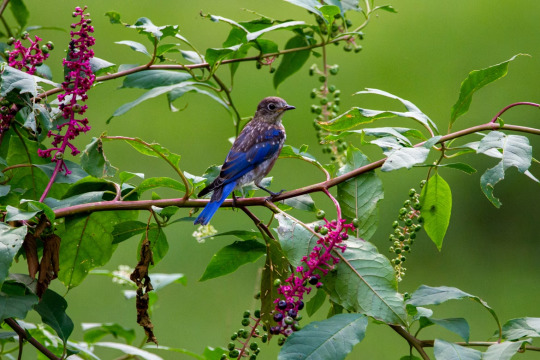

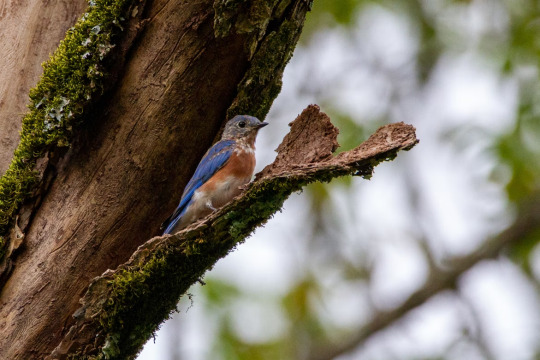

Eastern Bluebirds - Cypress Point Public Use Area, Ellzey Rd, Sardis, Mississippi, USA
Joshua J. Cotten
Scientific name: Sialia sialis
Conservation status: Least Concern (Population increasing)
Mass: 0.95 – 1.2 oz
Class: Aves
Domain: Eukaryota
Family: Turdidae
Genus: Sialia
The eastern bluebird is a small North American migratory thrush found in open woodlands, farmlands, and orchards.
#Cypress Point Public Use Area#Ellzey Rd#Sardis#Mississippi#USA#US#United States#United States of America#North America#MSWidlife#Bird#Birds#Wildlife#Eastern Bluebird#Sialia sialis#Aves#Eukaryota#Turdidae#Sialia
1 note
·
View note